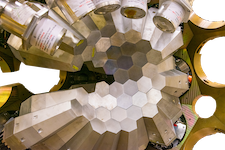Speaker
Description
The nucleus 68Se presents two rotational band structures that have been identified, on the basis of the moments of inertia, as oblate and prolate. The ground state band, presenting the characteristics of an oblate rotational band, is crossed at spin 8+ by a prolate-deformed band that becomes yrast. The second excited state in this nucleus is a 2+ state, allowing to study experimentally the two structures in a single experiment. Theoretical calculations performed with state-of-the-art large scale shell model predict utterly pure configurations with no mixing between the two bands. On the other hand, mean field Vampir calculations predict a large mixing of the two bands. This puts a very interesting question on the nature of these bands, the phenomenon of the shape coexistence and mixing. To answer to this question we propose to measure the lifetime of several states in this nuclei, mainly in the low-spin region via the DSAM technique. Excited states in 68Se will be populated using the 36Ar+40Ca reaction, with a PIAVE beam of 36Ar at an energy of 140 MeV and a gold-backed 40Ca target. The proposed set-up will require AGATA coupled to the EUCLIDES Si-ball. The beamtime request is 8 days.

